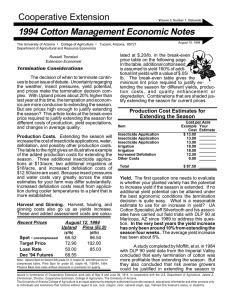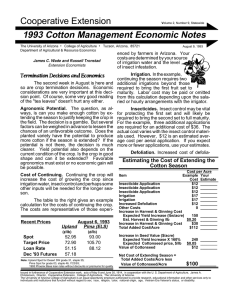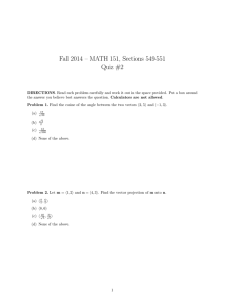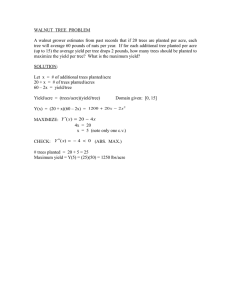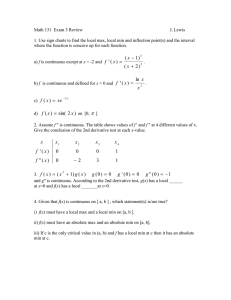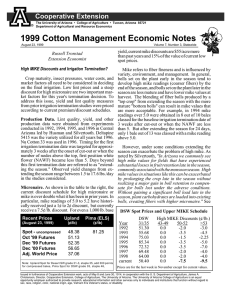Document 10685424
advertisement
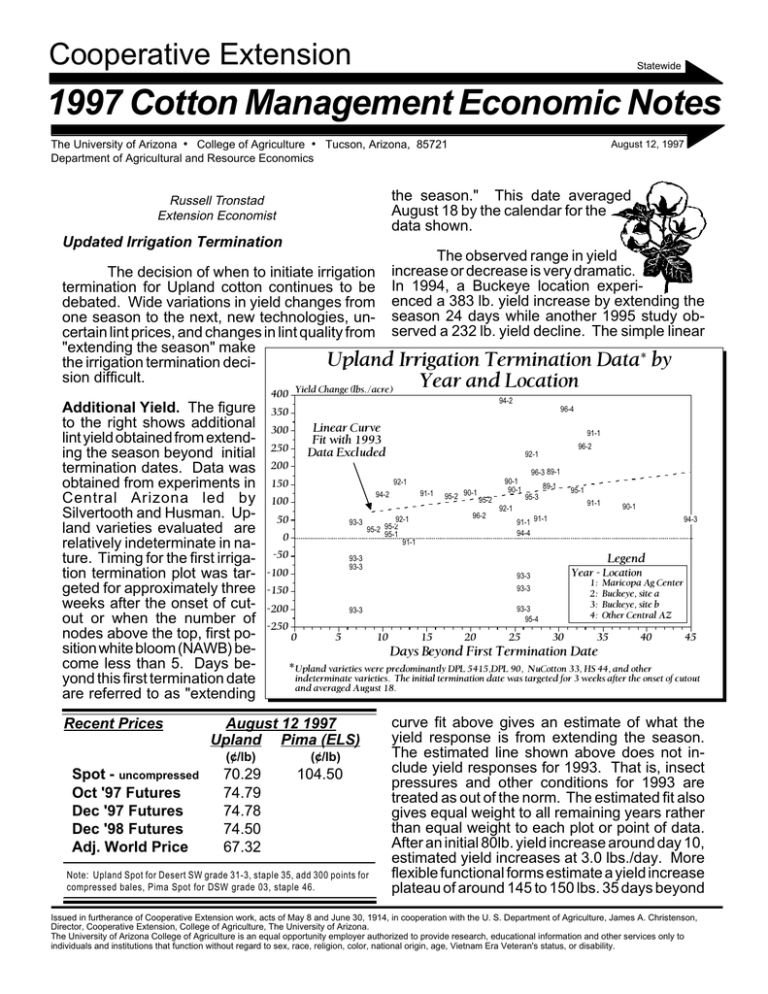
Cooperative Extension Statewide 1997 Cotton Management Economic Notes The University of Arizona • College of Agriculture • Tucson, Arizona, 85721 Department of Agricultural and Resource Economics August 12, 1997 the season." This date averaged August 18 by the calendar for the data shown. Russell Tronstad Extension Economist Updated Irrigation Termination The observed range in yield increase or decrease is very dramatic. In 1994, a Buckeye location experienced a 383 lb. yield increase by extending the season 24 days while another 1995 study observed a 232 lb. yield decline. The simple linear The decision of when to initiate irrigation termination for Upland cotton continues to be debated. Wide variations in yield changes from one season to the next, new technologies, uncertain lint prices, and changes in lint quality from "extending the season" make Upland the irrigation termination decision difficult. 400 Additional Yield. The figure to the right shows additional lint yield obtained from extending the season beyond initial termination dates. Data was obtained from experiments in Central Arizona led by Silvertooth and Husman. Upland varieties evaluated are relatively indeterminate in nature. Timing for the first irrigation termination plot was targeted for approximately three weeks after the onset of cutout or when the number of nodes above the top, first position white bloom (NAWB) become less than 5. Days beyond this first termination date are referred to as "extending Recent Prices 94-2 96-4 350 Linear Curve Fit with 1993 Data Excluded 300 250 70.29 74.79 74.78 74.50 67.32 91-1 96-2 92-1 200 96-3 89-1 150 92-1 91-1 94-2 100 50 93-3 0 -50 95-2 90-1 95-2 96-2 92-1 95-2 95-2 95-1 91-1 90-1 90-1 89-1 95-3 94-3 Legend Year - Location 1: 2: 3: 4: 93-3 -150 93-3 95-4 93-3 -250 0 5 90-1 91-1 91-1 94-4 93-3 -200 95-1 91-1 92-1 93-3 93-3 -100 10 15 20 25 30 Maricopa Ag Center Buckeye, site a Buckeye, site b Other Central AZ 35 40 45 Days Beyond First Termination Date varieties were predominantly DPL 5415,DPL 90, NuCotton 33, HS 44, and other *Upland indeterminate varieties. The initial termination date was targeted for 3 weeks after the onset of cutout and averaged August 18. August 12 1997 Upland Pima (ELS) (¢/lb) Spot - uncompressed Oct '97 Futures Dec '97 Futures Dec '98 Futures Adj. World Price Irrigation Termination Data* by Year and Location Yield Change (lbs./acre) (¢/lb) 104.50 Note: Upland Spot for Desert SW grade 31-3, staple 35, add 300 points for compressed bales, Pima Spot for DSW grade 03, staple 46. curve fit above gives an estimate of what the yield response is from extending the season. The estimated line shown above does not include yield responses for 1993. That is, insect pressures and other conditions for 1993 are treated as out of the norm. The estimated fit also gives equal weight to all remaining years rather than equal weight to each plot or point of data. After an initial 80lb. yield increase around day 10, estimated yield increases at 3.0 lbs./day. More flexible functional forms estimate a yield increase plateau of around 145 to 150 lbs. 35 days beyond Issued in furtherance of Cooperative Extension work, acts of May 8 and June 30, 1914, in cooperation with the U. S. Department of Agriculture, James A. Christenson, Director, Cooperative Extension, College of Agriculture, The University of Arizona. The University of Arizona College of Agriculture is an equal opportunity employer authorized to provide research, educational information and other services only to individuals and institutions that function without regard to sex, race, religion, color, national origin, age, Vietnam Era Veteran's status, or disability. Quality. Extending the season has been known to reduce the number of immature fibers and improve quality, Increase in Production Costs* ($/acre) $200 but extending the season also risks $185 deteriorating quality with adverse $170 weather and insect pressures. Lint $155 quality changes have a dramatic imMaybe $140 pact on profit since both the "base Profitable $125 yield" and additional yield are affected. Unprofitable Using a base yield of 1,200 lbs./acre, $110 80 75 70 65 the figure in the lower right corner $95 60 cents/lb. gives the additional yield required to $80 justify extending the season for a range $65 of lint quality changes from -3¢/lb. to Profitable $50 +2¢/lb. A higher base yield would $35 increase (decrease) the amount of $20 additional lint required to break-even $5 with a degradation (enhancement) in 5 35 65 95 125 155 185 215 245 275 305 335 365 lint quality. As highlighted with the Additional Yield (lbs. lint per acre) dashed lines below, the $80 cost *Additional costs for ginning, harvest, and opportunity cost of money are accounted for in the figure. Production Cost increases include water, insecticide, defoliation, and other growing costs. increase illustrated earlier requires 188 lbs. instead of 146 lbs. to breakthe first termination date. But is this yield increase even with a 2¢/lb. quality degradation. That is, profitable with higher production, harvest, gin- more than 188 lbs. of additional lint are required before extending the season becomes profitable ning, and other costs? with a 2¢/lb. degradation in lint quality. Production Costs. Extending the season will increase the cost of insecticide applications, wa- Risk Return Assessment. The decision of when ter, defoliation, and possibly other production to terminate also depends on other factors, includcosts. For illustration, say that two additional ing the amount of risk you are able and willing to insecticide applications at $15/acre, two addi- take on. If your economics for extending the tional irrigations at $19/acre, and increased defo- season look promising, a wise strategy may be to liation costs of $12/acre are required. The figure diversify by extending the season on part of your above indicates that for this $80/acre increase in acreage while terminating the rest. production cost it would take Yield Increases Needed to Justify Extending the Season with 70¢ 146 lbs. of lint to just break-even Cotton for Different Cost Increases and Changes in Lint Quality from extending the season with Increase in Production Costs* ($/acre) 70¢ cotton. These cost esti250 lbs. acre 300 lbs. acre lbs./acre mates may differ substantially $140 lbs./acre even within a county due to dif- $125 200 lbs. acre ferent water sources and insect lbs./acre lbs./acre pressures. $110 Lint Price (¢/lb.) Required to Justify "Extending the Season" for Different Cost Increases* 250 lbs. acre Harvest, Ginning and Finance. Harvest, hauling, and ginning costs are accounted for in the above figure at $.20/lb. Additional cottonseed is assumed to yield 160% of additional lint yields with a value of $.05/lb. Extending the season also means that the crop will be sold at a later date, increasing finance charges. Funds are charged at an annual rate of 10% with a base yield of 1,200 lbs., amounting to $4.83/acre for 21 days. 150 lbs. acre $95 $80 lbs./acre 200 100 lbs. acre $65 $50 150 50 $35 100 $20 0 $5 $-0.03 50 $-0.02 $-0.01 $0.00 $0.01 $0.02 Change in Lint Quality ($/lb.) * Additional costs for ginning, harvest, and opportunity cost of money are accounted for in the figure. Increase in production costs are for water, insecticide, defoliation, and other growing costs. Disclaimer: Neither the issuing individuals, originating unit, Arizona Cooperative Extension, nor the Arizona Board of Regents warrant or guarantee the use or results of this publication issued by the Arizona Cooperative Extension and its cooperating Departments and Offices.
